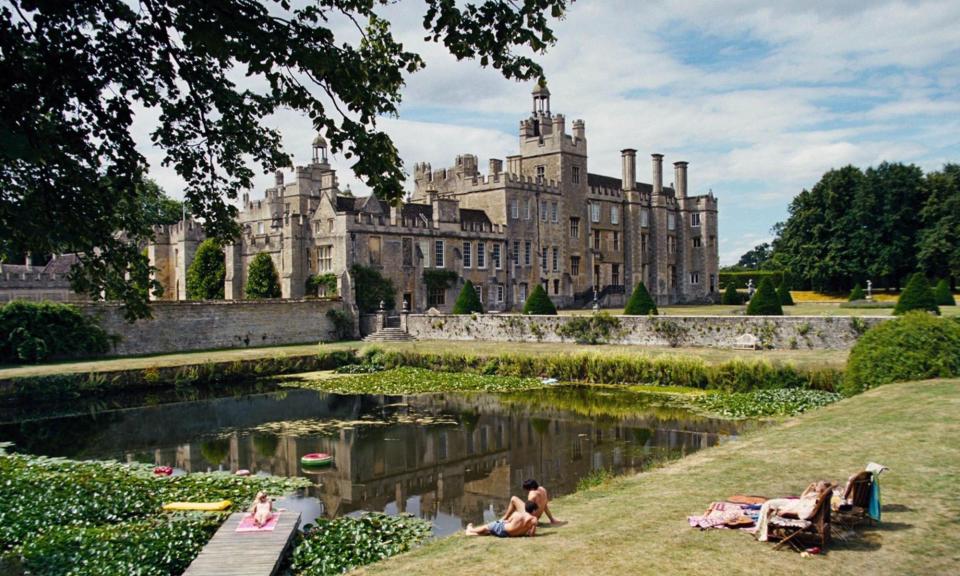Insurer warns owners of ‘Saltburn effect’ from using stately homes for filming

When the owner of Drayton House in Northamptonshire was approached to allow his 127-room mansion to be the location of a film called Saltburn, it was “100%” the generous fee on offer that swayed his decision, he said, adding: “These houses don’t run on water.”
But there were unintended consequences of Charles Stopford Sackville’s decision after the movie’s release last year. The popularity of Emerald Fennell’s class satire led to a rush of selfie-taking trespassers after TikTok videos giving directions to the estate went viral.
Now one leading heritage insurance firm has issued detailed guidance to the owners of historic properties on how best to avoid what it has called “the Saltburn effect”.
Unwelcome or excessive visitors are far from the only possible consequence of agreeing to be a film location, according to the advice from Ecclesiastical. The specialist insurer highlights the risk of breakages or damage, disputes over location limits and the possibility of reputational harm.
The insurer points to Netflix’s period romp Bridgerton, the third series of which returns this week and which has been filmed at several grand locations including Castle Howard in Yorkshire and Ranger’s House in Greenwich, London. Nicola Coughlan, who plays Penelope Featherington in the series, has said she and her co-star Luke Newton broke an item of furniture while filming an intimate scene, though she has not specified if it was a historic piece.
Breakages most commonly happen during the setup or take down of filming sets, according to the insurer. It said that on the first day of filming Downton Abbey at Highclere Castle in Berkshire, a turquoise chest belonging to the Countess of Carnarvon was knocked on to the floor and broken, requiring repair at Sotheby’s.
Much of the advice offered is common sense, stressing the need for setting “robust contracts and agreements, bespoke to your premise and its operation”.
Owners are advised to consider issues that would be common to any production, such as vehicle access, cabling routes, security and the location of the smoking areas.
But there are other questions that only highly privileged owners will need to consider. Will the filming disrupt your guided tours? What if the production wants to light a fire in your historic fireplace? Do you need to arrange storage for your valuable works of art?
The guidance warns: “Sensitivity of the subject or theme and nature of the filming is something that should feature in the very earliest of considerations, and ideally from the outset during the initial approach.” While the net result can often be extremely positive, “there could also be an unexpected association with your property”.
In the case of Saltburn, which features scenes of graphic sex and murder and concludes with Barry Keoghan dancing naked around its grand rooms, Drayton House’s owner appeared relaxed about the content, although he told the Daily Mail: “There are bits I liked and bits I wouldn’t necessarily have put in myself.”
According to Tatler, however, part of the deal Stopford Sackville struck with Saltburn’s producers stipulated that no one reveal where the movie had been filmed, meaning the location could not be mentioned in interviews. But, as the article says, “when the trailer premiered, how could one not recognise the spiral cantilever oak staircase and distinctive medieval great hall?”
Laura Carter, a director at Ecclesiastical Insurance, said there was “always a bit of excitement” when a new series featured a much-loved historic building.
“It brings with it potential financial reward, including an influx of visitors, and can really boost the profile of a stately home or visitor attraction,” she said.
“However, as we saw with the response to Saltburn, there can be pitfalls in letting your heritage property be used for filming and that’s why we’ve launched this guidance. We aren’t telling property owners to say no to production crews, instead we’re giving them the advice they need to make the best decision and take the necessary steps to protect themselves.”

 Yahoo Sport
Yahoo Sport 






































